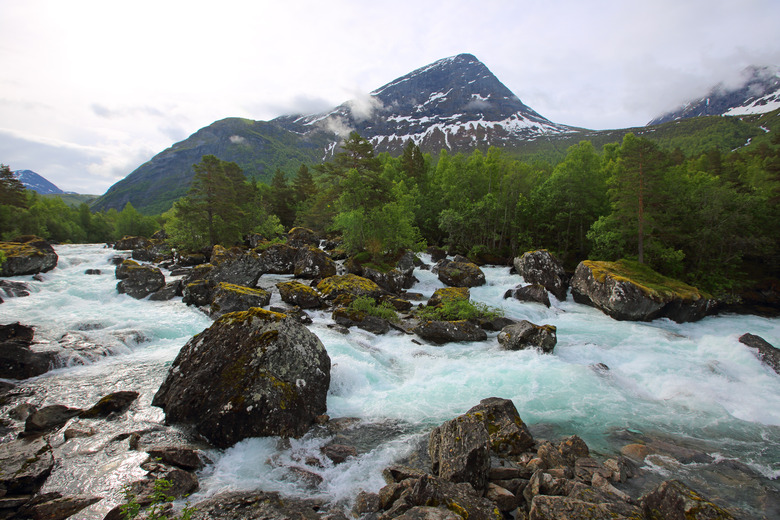Factors Affecting A River's Velocity
A river's velocity refers to the speed at which water moves through its channel. The velocity of a river is determined by many factors, including the shape of its channel, the gradient of the slope that the river moves along, the volume of water that the river carries and the amount of friction caused by rough edges within the riverbed. The velocity can change at various points along the course of a river.
Channel Shape
Channel Shape
The shape of the channel affects the velocity of a river. Around the perimeter of the river — that is, at the sides and along the river bed — friction is created as water flows against the edges. Water flowing through a wide, deep river channel encounters less resistance than water flowing in a narrow, shallow channel, since a smaller proportion of the total water molecules will be slowed by the river's edges. The center of the river experiences the greatest velocity.
Volume of Water
Volume of Water
The volume of water that flows through a river within a given amount of time — known as the discharge — also affects its velocity. As the volume of water in a river increases, through smaller streams flowing into it, for example, the velocity of the river increases. An increase in water volume can also affect a river's velocity in the long term; this is because the increasing mass of water is capable of causing more erosion, resulting in a wider, deeper river channel that allows water to flow more freely.
Smooth and Rough Channels
Smooth and Rough Channels
Rough river channels contain a large quantity of rocks, pebbles and boulders, either at the bottom of the river or embedded within its sides. A great deal of friction is created between water molecules and these stones as the river flows past them; in rough channels, the resistance caused by this friction reduces the river's velocity. In a smooth river channel, with fewer pebbles and rocks, velocity is higher because there is less friction causing energy to be expended as it flows.
Riverbed's Gradient
Riverbed's Gradient
The gradient of a river refers to how steep its slope is; this also has a significant effect on the velocity of a river. When a river flows down a steep slope, the gravitational force that pulls the water downward is stronger than it would be on water flowing down a gentle slope, resulting in the river having a greater level of velocity.
Cite This Article
MLA
Ames, Hayley. "Factors Affecting A River's Velocity" sciencing.com, https://www.sciencing.com/factors-affecting-rivers-velocity-8223150/. 20 April 2018.
APA
Ames, Hayley. (2018, April 20). Factors Affecting A River's Velocity. sciencing.com. Retrieved from https://www.sciencing.com/factors-affecting-rivers-velocity-8223150/
Chicago
Ames, Hayley. Factors Affecting A River's Velocity last modified March 24, 2022. https://www.sciencing.com/factors-affecting-rivers-velocity-8223150/
